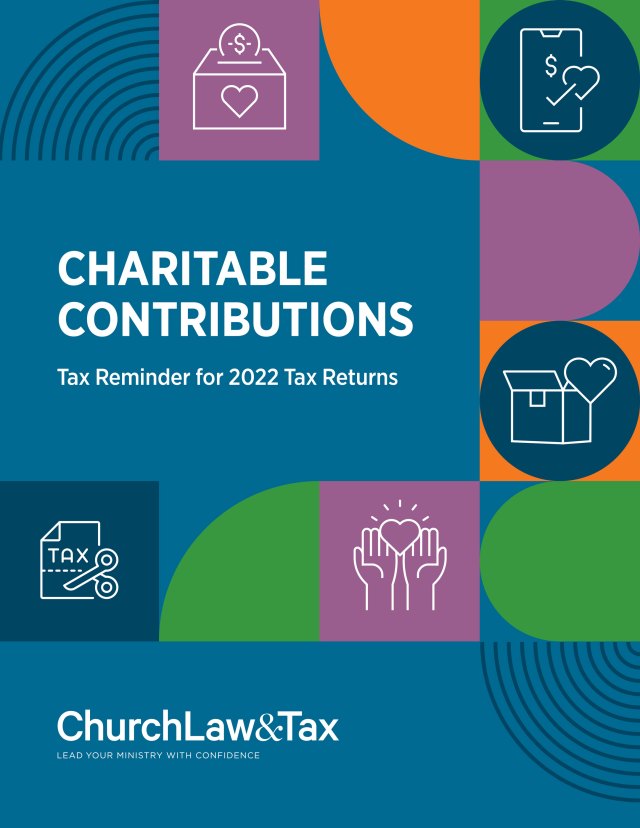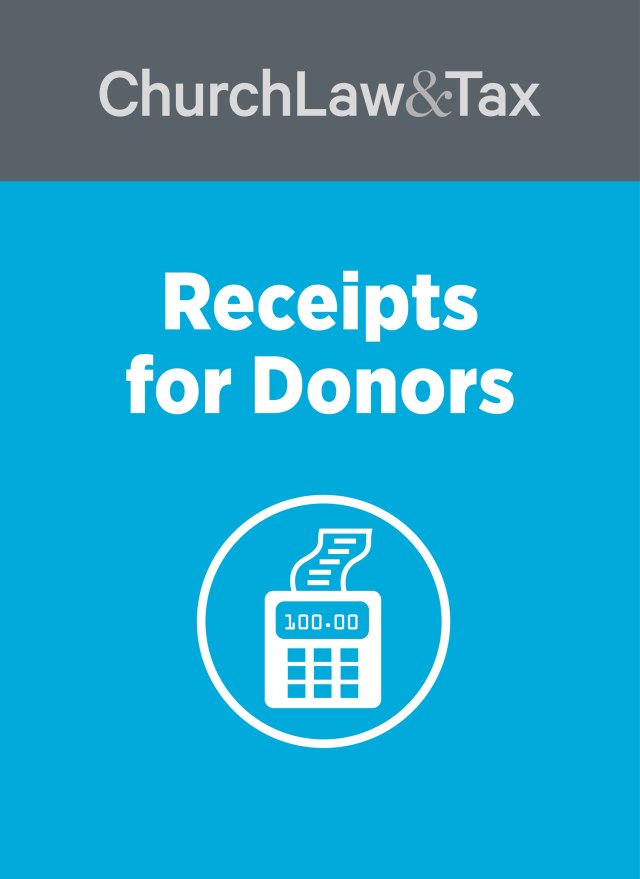Church treasurers will be pleased to learn that the IRS recently issued Publication 1771, which explains the substantiation requirements that apply to certain charitable contributions. The publication contains helpful information for both churches and donors. This article will review Publication 1771 and explain its significance to church treasurers.
Publication 1771 begins by noting that there are two general rules that charities need to follow to meet the substantiation and disclosure requirements of federal tax law.
Rule #1. Written acknowledgment. A donor is responsible for obtaining a written acknowledgment from a charity for any single contribution of $250 or more before the donor can claim a charitable contribution on his or her federal income tax return.
Rule #2. Written disclosure. A charity is required to provide a written disclosure to a donor who receives goods or services in exchange for a single payment in excess of $75.
The publication’s treatment of each of these two rules is summarized below.
Key point. Publication 1771 does not address the substantiation requirements that apply to contributions of less than $250, or contributions of noncash property. These rules are explained fully in chapter 8 of Richard Hammar’s 2002 Church & Clergy Tax Guide.
Rule #1. Written Acknowledgment
Publication 1771 states that “a donor cannot claim a tax deduction for any single contribution of $250 or more unless the donor obtains a contemporaneous, written acknowledgment of the contribution from the recipient organization. An organization that does not acknowledge a contribution incurs no penalty; but without a written acknowledgment the donor cannot claim the tax deduction.”
A written acknowledgement should contain the following information: (1) name of the charity; (2) amount of the cash contribution; a description (but not the value) of non-cash contributions; (3) a statement that no goods or services were provided by the charity in return for the contribution, if that was the case; (4) a description and good faith estimate of the value of goods or services, if any, that the charity provided in return for the contribution; and (5) a statement that goods or services, if any, that the charity provided in return for the contribution consisted entirely of “intangible religious benefits,” if that was the case.
Key point. It is not necessary to include the donor’s social security number on the acknowledgment.
Written acknowledgments must be “contemporaneous” with the contribution. This means that a donor must receive the acknowledgment by the earlier of (1) the date on which the donor actually files his or her individual federal income tax return for the year of the contribution, or (2) the due date (including extensions) of the return.
Format of written acknowledgments
There are no required forms for the acknowledgment. Publication 1771 states that “letters, postcards, or computer-generated forms with the above information are acceptable. An organization can provide either a paper copy of the acknowledgment to the donor, or an organization can provide the acknowledgment electronically, such as via an e-mail addressed to the donor.” This is an important clarification that will assist donors in complying with the substantiation requirements. Consider the following examples.
Example. Don made weekly contributions to his church in 2001 of $50. In December, he also made a $10,000 contribution to the church building fund. The church issued Don a “contribution summary” in January 2002 that did not include all of the information required for a written acknowledgment of a contribution of $250 or more. Don files his tax return on April 15, 2002. If Don is audited, the $10,000 contribution may be disallowed because Don did not receive a “contemporaneous, written acknowledgment” of this contribution containing all of the required information summarized above by the earlier of (1) the date he filed his federal income tax return for the year of the contribution, or (2) the due date of the return.
Example. Same facts as the previous example, except that on April 15, 2002 Don’s tax preparer realizes that Don does not have an adequate “contemporaneous, written acknowledgment” to support the $10,000 contribution. The tax preparer contacts Don’s church, and describes the information that must be contained in a written acknowledgment. Later that day, the church treasurer emails the tax preparer a written acknowledgment that complies with the substantiation requirements summarized above. According to Publication 1771, the email sent on April 15 by the church treasurer to Don’s tax preparer will satisfy the “contemporaneous, written acknowledgment” requirement.
A donor should not attach the acknowledgment to his or her individual income tax return, but must retain it to substantiate the contribution. Separate contributions of less than $250 will not be aggregated. An example of this could be weekly offerings to a donor’s church of less than $250, even though the donor’s annual total contributions are $250 or more.
Publication 1771 lists the following examples of written acknowledgments:
- “Thank you for your cash contribution of $300 that (organization’s name) received on December 12, 2001. No goods or services were provided in exchange for your contribution.”
- “Thank you for your cash contribution of $350 that (organization’s name) received on May 6, 2001. In exchange for your contribution, we gave you a cookbook with an estimated fair market value of $60.”
- “Thank you for your contribution of a used oak baby crib and matching dresser that (organization’s name) charity received on March 15, 2001. No goods or services were provided in exchange for your contribution.”
The following is an example of a written acknowledgment where a charity accepts contributions in the name of one of its activities.
• “Thank you for your contribution of $450 to (organization’s name) made in the name of its Special Relief Fund program. No goods or services were provided in exchange for your contribution.”
One acknowledgment, or several
Must a church provide an individual written acknowledgment for each contribution of $250 or more, or can it combine them in one acknowledgment? Publication 1771 states, “A separate acknowledgment may be provided for each single contribution of $250 or more, or one acknowledgment, such as an annual summary, may be used to substantiate several single contributions of $250 or more.”
Goods or services
As noted above, a written acknowledgment must describe “goods or services” that a charity provides to a donor in exchange for a contribution of $250 or more. It must also provide a good faith estimate of the value of such goods or services because a donor generally must reduce the amount of the contribution deduction by the fair market value of the goods and services provided by the charity. Goods or services include cash, property, services, benefits or privileges. However, Publication 1771 mentions the following exceptions.
1. Token exception. “Insubstantial” goods or services that a charity provides to a donor in exchange for a contribution do not have to be described in the acknowledgment. Goods and services are considered to be insubstantial “if the payment occurs in the context of a fund-raising campaign in which a charitable organization informs the donor of the amount of the contribution that is a deductible contribution, and: (1) the fair market value of the benefits received does not exceed the lesser of 2 percent of the payment or $76, or (2) the payment is at least $38, the only items provided bear the organization’s name or logo (e.g., calendars, mugs, or posters), and the cost of these items is within the limits for low-cost articles, which is $7.60.” These dollar amounts are adjusted each year for inflation, and represent the 2001 amounts (the 2002 amounts had not been released at the time of publication).
2. Intangible religious benefits exception. If a religious organization provides only “intangible religious benefits” to a donor, the written acknowledgment does not need to describe or value those benefits. It can simply state that the organization provided intangible religious benefits to the contributor.
What are “intangible religious benefits”?Publication 1771 defines them as “benefits provided by a tax-exempt organization operated exclusively for religious purposes, and not usually sold in commercial transactions outside a donative (gift) context. Examples include admission to a religious ceremony and a de minimis tangible benefit, such as wine used in a religious ceremony. Benefits that are not intangible religious benefits include education leading to a recognized degree, travel services, and consumer goods.”
Unreimbursed expenses
It is common for church members to claim a single contribution of $250 or more in the form of unreimbursed expenses incurred in performing donated services. A common example would be a group of adults who go on a short-term missions trip at their own expense. Members who participate on the trip, and who incur out-of-pocket expenses of $250 or more, are entitled to a charitable contribution deduction (assuming they otherwise qualify). But, since their contribution is for $250 or more, the more intensive substantiation rules summarized in this article apply. Publication 1771 states that in such a case the donor must obtain a written acknowledgment from the church containing the following information:
- A description of the services provided by the donor
- A statement of whether or not the church provided goods or services in return for the contribution
- A description and good faith estimate of the value of goods or services, if any, that the church provided in return for the contribution
- A statement that goods or services, if any, that the church provided in return for the contribution consisted entirely of intangible religious benefits (described earlier), if that was the case
In addition, a donor must maintain adequate records of the unreimbursed expenses. Publication 1771 gives the following example:
Example. A chosen representative to an annual convention of a charitable organization purchases an airline ticket to travel to the convention. The organization does not reimburse the delegate for the $500 ticket. The representative should keep a record of the expenditure, such as a copy of the ticket. The representative should obtain from the organization a description of the services that the representative provided and a statement that the representative received no goods or services from the organization.
Rule #2. Written Disclosure
It is a fundamental principle of tax law that donors may claim a contribution deduction only to the extent that their contribution exceeds the fair market value of any goods or services they receive in exchange.To illustrate, if a church operates a school that charges annual tuition of $3,000, parents cannot claim any contribution deduction for the tuition they pay to the school since they are receiving a return benefit that is equal to the value of their payment. However, if a parent issues the school a check in the amount of $4,000, he or she will be entitled to a contribution deduction of $1,000 (the amount by which the payment exceeds the value of goods or services received in exchange).
A charity must provide a “written disclosure statement” to a donor who makes a payment exceeding $75 that is partly a contribution and partly for goods and services provided by the charity. A contribution made by a donor in exchange for goods or services is known as a quid pro quo contribution. Publication 1771 notes that a written disclosure statement must:
- Inform a donor that the amount of the contribution that is deductible for federal income tax purposes is limited to the excess of money (and the fair market value of property other than money) contributed by the donor over the value of goods or services provided by the charity
- Provide a donor with a good-faith estimate of the fair market value of the goods or services
A written disclosure statement is not required if the goods or services given to a donor meet the “token exception” or “intangible religious benefits exception” described above.
This article first appeared in Church Treasurer Alert, May 2002.

